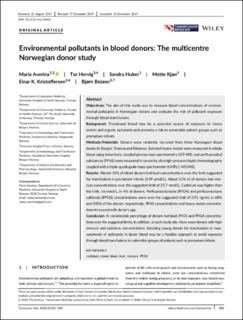Environmental pollutants in blood donors: The multicentre Norwegian donor study
Averina, Maria; Hervig, Tor; Huber, Sandra; Kjær, Mette; Kristoffersen, Einar Klæboe; Bolann, Bjørn Johan
Journal article, Peer reviewed
Published version

Åpne
Permanent lenke
https://hdl.handle.net/11250/2730414Utgivelsesdato
2020Metadata
Vis full innførselSamlinger
- Department of Clinical Science [2375]
- Registrations from Cristin [10186]
Sammendrag
Objectives
The aim of this study was to measure blood concentrations of environmental pollutants in Norwegian donors and evaluate the risk of pollutant exposure through blood transfusions.
Background
Transfused blood may be a potential source of exposure to heavy metals and organic pollutants and presents a risk to vulnerable patient groups such as premature infants.
Methods/Materials
Donors were randomly recruited from three Norwegian blood banks: in Bergen, Tromsø and Kirkenes. Selected heavy metals were measured in whole blood using inductively coupled plasma mass spectrometry (ICP‐MS), and perfluoroalkyl substances (PFAS) were measured in serum by ultrahigh‐pressure liquid chromatography coupled with a triple‐quadrupole mass spectrometer (UHPLC‐MS/MS).
Results
Almost 18% of blood donors had lead concentrations over the limit suggested for transfusions in premature infants (0.09 μmol/L). About 11% of all donors had mercury concentrations over the suggested limit of 23.7 nmol/L. Cadmium was higher than the limit, 16 nmol/L, in 4% of donors. Perfluorooctanoate (PFOA) and perfluorooctane sulfonate (PFOS) concentrations were over the suggested limit of 0.91 ng/mL in 68% and 100% of the donors, respectively. PFAS concentrations and heavy metal concentrations increased with donor's age.
Conclusion
A considerable percentage of donors had lead, PFOS and PFOA concentrations over the suggested limits. In addition, at each study site, there were donors with high mercury and cadmium concentrations. Selecting young donors for transfusions or measurements of pollutants in donor blood may be a feasible approach to avoid exposure through blood transfusions to vulnerable groups of patients such as premature infants.
